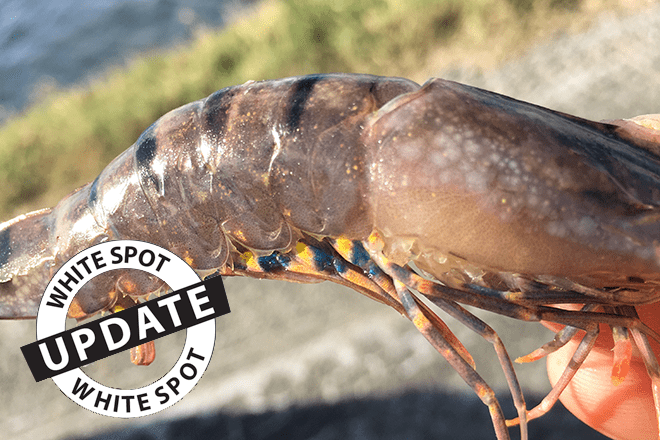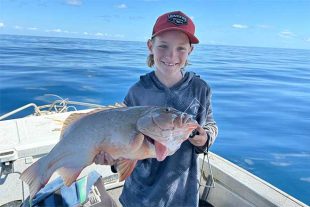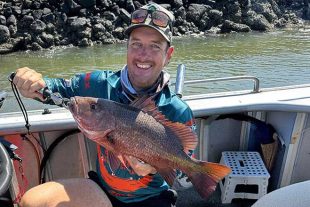A GOLD Coast bait supplier who moved raw prawns outside the movement restriction area and sold them to a bait shop in the Warwick region has been fined $10,000 in the Brisbane Magistrates’ Court.
The Magistrate said the penalty should send a clear message to other industry operators and the public warning them that they will be punished if they breach a Movement Control Order.
Minister for Agricultural Industry Development and Fisheries Mark Furner said the prawns were collected from the retail outlet by a government employee and sent to the Biosecurity Sciences Laboratory for testing and Australian Animal Health Laboratory for further confirmation.
“Once the bait prawns tested positive for white spot syndrome virus all at-risk prawns associated with the consignment were immediately traced and removed from sale,” Mr Furner said. “We also conducted surveillance in local rivers and dams in the area, with all tests returning negative results. “It is very lucky the consignment was detected quickly and the bait recalled, otherwise someone could have unknowingly spread white spot disease to new waterways in the area. Commercial bait suppliers operating in the white spot disease restricted area should take heed from this and realise it is a criminal offence to move raw prawns, yabbies and marine worms out of the area.”
The defendant pleaded guilty to charges of failing to comply with a movement control order, which was made under the Biosecurity Act 2014. Movement restrictions are in place to safeguard the aquaculture industry, commercial fishers and the environment from further spread of white spot disease. The restrictions are in place from Caloundra to the New South Wales border, and west to Ipswich for prawns, yabbies and marine worms.
Meeting with commercial fishers
Biosecurity Queensland representatives met with approximately 30 commercial fishers at Scarborough on Friday 27 July to discuss industry issues around white spot disease in the Moreton Bay area.
Issues that were discussed:
- The impacts and risks of green imported prawns for the industry
- Progress of a bait treatment research project which aims to establish an economically viable means to enable trade in bait prawns out of south east Queensland.
- Compliance around moving green prawns, yabbies and marine worms out of the movement restriction area
White spot disease surveillance results
Prawn and crab samples were collected from 54 sites in the Moreton Bay area to test for the virus that causes white spot disease. Nine sites returned positive results in the northern part near Deception Bay and Redcliffe Peninsula. The surveillance results and a map of the surveillance area are available on the DAF website.
Along the east coast of Queensland samples were collected from 10 sites from Caloundra through to Cairns, the surveillance results and a map of the surveillance sites are also available on the DAF website.
If viewing the maps from a desktop computer, click on each surveillance site (green or red dot) and more information such as sample numbers and species will appear in a panel on the left hand side of the screen.
Do these results mean WSD is here to stay?
All states and territories in Australia are currently undergoing proof of freedom surveillance for the virus that causes white spot disease. No decision will be made about whether the disease will be considered established in Moreton Bay or not until all those results have been finalised.
Have movement restrictions changed?
No. Movement restrictions remain unchanged across Moreton Bay which means prawns, yabbies and marine worms cannot be moved out of the area, unless cooked first.
Can white spot disease be eradicated?
White spot disease is an extremely contagious viral disease that is present in many areas of the world. Once it has been established in a wild crustacean population it has not been known to be eradicated. At this stage, we don’t know if the virus that causes white spot disease has established in wild crustaceans in Moreton Bay. It is important that we complete testing in all states and territories before making any decisions on the future of our white spot disease strategy.
Fishing restrictions in place along Logan River
Fishing restrictions are in place around all prawn farms in the Logan River region.
Because fishing near these farms could introduce serious diseases, line fishing is prohibited within 100 metres of prawn farm water intake and outlet channels and all fishing is prohibited in drainage channels surrounding these prawn farms.
Crab pots, cast nets and yabby pumps can be used in waterways adjacent to prawn farms, unless signage states otherwise. Raw prawns, yabbies and marine worms cannot be moved out of the white spot disease movement restriction area.
The fishing restrictions apply to waterways surrounding prawn farms in Alberton, Coomera, Gilberton, Helensvale, Hope Island, Jacobs Well, Norwell, Ormeau, Pimpama, Southern Moreton Bay Islands, Stapylton, Steiglitz and Woongoolba.
Why are the fishing restrictions in place?
Prawn farms are high-risk areas for aquatic diseases. Fishing in these areas may increase the likelihood of a disease being introduced to the farm if contaminated bait is used.
How long will the restrictions be in place?
The fishing restrictions are in place indefinitely.
Where exactly are the restricted areas?
The restrictions apply to all prawn farms in the Logan River region. A map showing the locations of where fishing is now restricted is available at daf.qld.gov.au/wsd.
Reporting white spot disease
Prawns with white spot disease may have a loose shell with numerous white spots (0.5–2.0 mm in diameter) on the inside surface of the shell and a pink to red discolouration.
Suspected cases of white spot disease must be reported to Biosecurity Queensland immediately through the online white spot disease reporting form or by calling 13 25 23. Take note of the location and time and if possible, freeze a sample of the suspect animals for later testing.
Further information
Further information on white spot is available on the Department of Agriculture and Fisheries website.
Subscribe to the Department of Agriculture and Fisheries aquatic pest and disease alerts for regular updates on the white spot disease response.
 Bush ‘n Beach Fishing Magazine Location reports & tips for fishing, boating, camping, kayaking, 4WDing in Queensland and Northern NSW
Bush ‘n Beach Fishing Magazine Location reports & tips for fishing, boating, camping, kayaking, 4WDing in Queensland and Northern NSW









